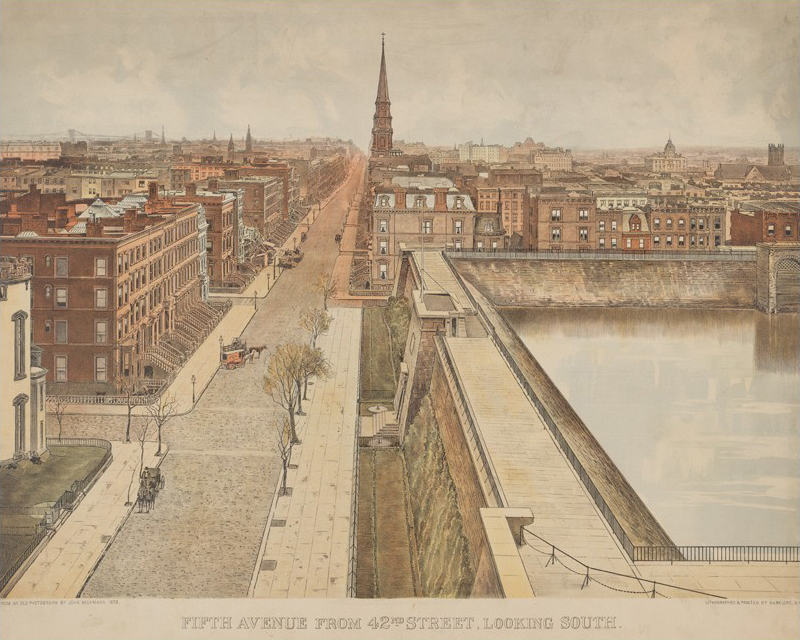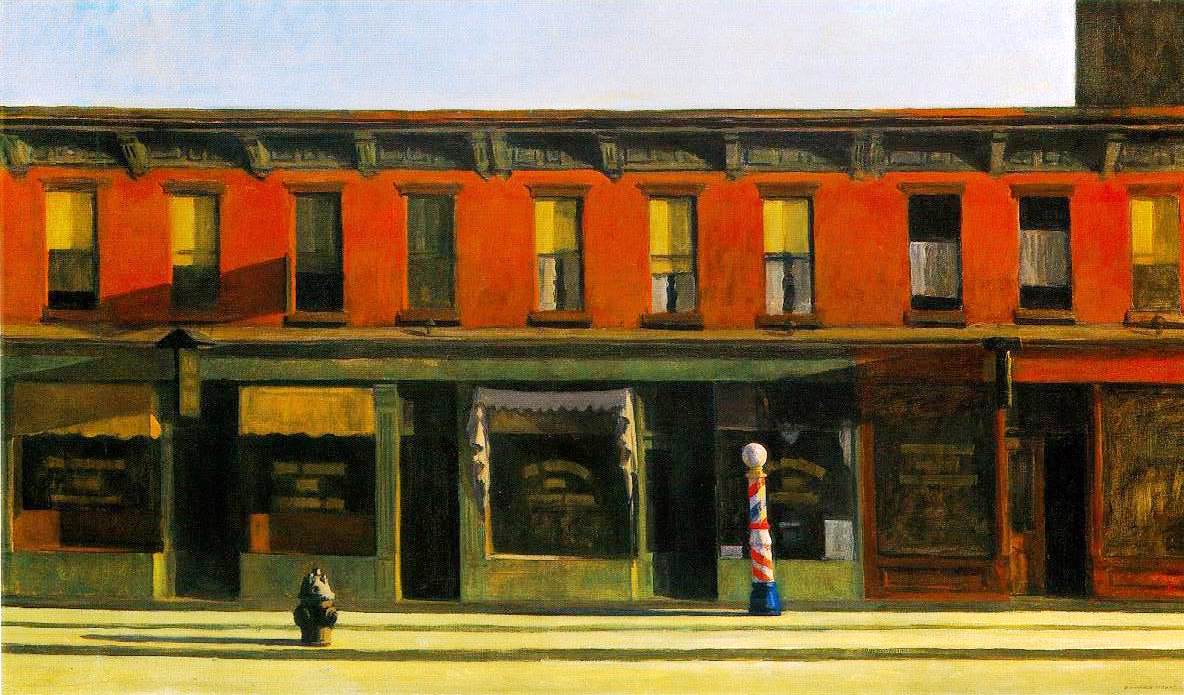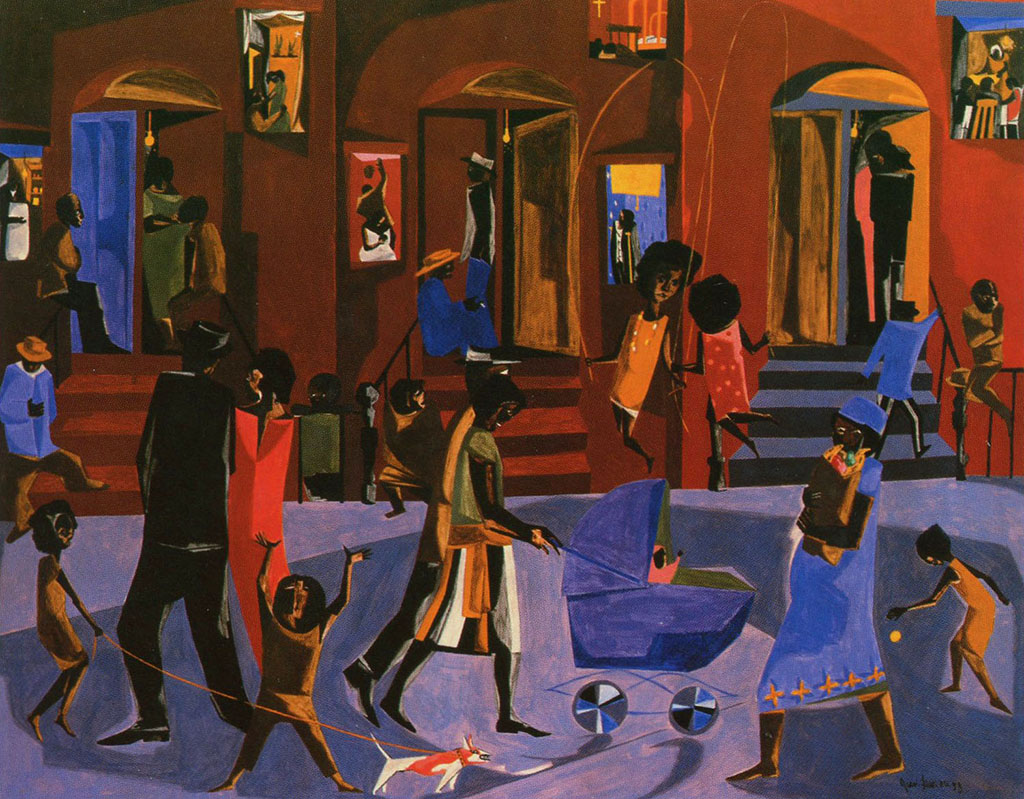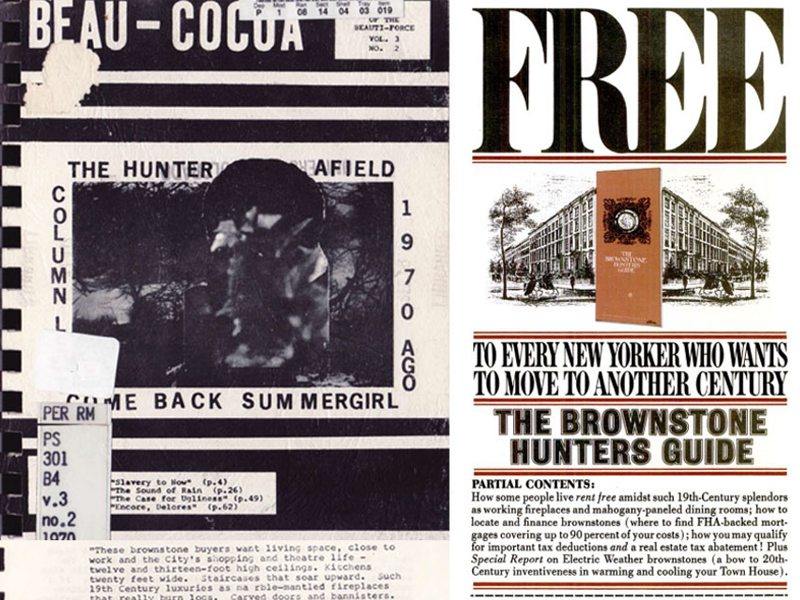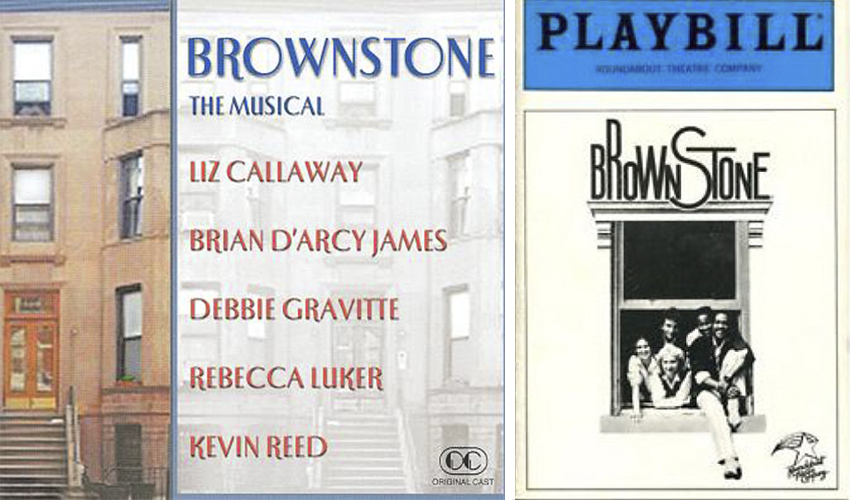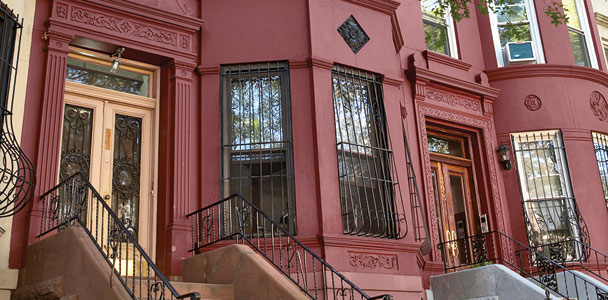Typecast
The Architectural League’s long-term investigation into architectural typologies that have come to be seen as outdated, stagnant, or obsolete.
In This SeriesWe are celebrating 15 years — and counting — of stories that are deeply researched and deeply felt, that build a historical record of what the city has been.
The monuments of New York City—Central Park, the Chrysler Building, the Brooklyn Bridge—are shorthand place-setting mechanisms for any number of filmic moments. But when the camera lowers, it often lands on a humbler, but equally distinctive, form. The city’s row houses and brownstones read as authentically New York—signifiers of stability, mobility, and a certain urbane sensibility. So we asked: Over a century of novels, works of art, films, and television shows, what does the row house say about specific eras, neighborhoods, and lifestyles? The row house is both objectified—a vessel for the desires and aspirations of the upwardly mobile—and personified, a quirky character in its own right.
Queens, the Bronx, and Staten Island don’t feature often enough into our public imaginary—Archie Bunker lived in a semi-detached house (the row house’s close cousin), but most of our fictions are set in the two densest boroughs. The Upper East Side brownstone was long the backdrop for old money conflict (in Edith Wharton and Louis Auchincloss’s novels) and upwardly mobile dreamers (Holly Golightly and Carrie Bradshaw). Then, as the center of New York’s gravity (its film and literary gravity, at least) migrates from Manhattan to Brooklyn, the leafy streets of brownstone Brooklyn have become the de facto setting for young white strivers. Bed-Stuy appears as a locus for racial conflict, as when Buggin’ Out confronts a flippant white neighbor in Do the Right Thing (1989): “Who told you to buy a brownstone on my block, in my neighborhood, on my side of the street?”
We could have replaced this list ten times over with other literary and filmic moments starring New York’s brownstones. These examples offer a look into the city’s problems as well as the unbridled joys it can bring, with the row house regularly starring as a container for (fictitious) New Yorkers’ dreams. There’s a reason Bert and Ernie share the garden apartment of a brownstone at 123 Sesame Street. –E.S.
No one knew—or wrote—of Gilded Age Upper East Side high society scandal like Edith Wharton. In her 1920 novel, Wharton takes care to note the displays of wealth inscribed in the aesthetics of Upper East Side row houses. The character Catherine Manson Mingott, inspired by Wharton’s real-life great aunt Mary Mason Jones, “put the crowning touch to her audacities by building a large house of pale cream-coloured stone (when brown sandstone seemed as much the only wear as a frock-coat in the afternoon).” Wharton had a long fascination with architecture that began with her first published book, The Decoration of Houses. While the author’s description of New York life in The Age of Innocence may be read as a glorification of wealth, Wharton critiqued the Victorian social standards that produced such extravagant architecture. In her 1938 Harper’sarticle “A Little Girl’s New York,” she wrote, “I have often sighed, in looking back at my childhood, to think how pitiful a provision was made for the life of the imagination behind those uniform brownstone facades. . .Beauty, passion, and danger were automatically excluded.”
The row houses of New York are distinctive, immediate symbols of the city. But Hopper’s painting of the row house storefronts lining Seventh Avenue in Greenwich Village is intentionally oblique—the windows’ painted lettering and signs are almost entirely effaced, and the lack of plants, animals, or human figures makes the scene surreally quiet, especially for New York. It’s almost more believable as Main Street, Middle America. Some art historians read this as a depiction of the Great Depression, others think it speaks to the threat posed to New York’s way of life by commerce and industrialization. Either way, Hopper makes his point by paring the scene down to its architectural bones, giving a window on the New York row house that’s uncommonly spare and unusually emotive.
Lawrence is widely regarded as the greatest painter of the Great Migration, and his paintings—including Brownstones—contain the whole energetic, emerging ecosystem of 1950s Harlem. Like Edward Hopper, Lawrence reduces the brownstone to its essential elements—the rich red-brown of the facades, the rhythm of the front steps, the double doors giving glimpses of bustling interiors. But unlike Hopper, Lawrence uses this simplicity to put human activity front and center. Figures stack on top of one another, each component scene full of its own joyful music.
The energy of the Harlem Renaissance jazz scene—historic and innovative, intimate and crackling with art—is clearly visible in this iconic 1958 photograph. It was Art Kane’s first professional picture, launching a career that would include photographing of Bob Dylan, Aretha Franklin, and the Rolling Stones, and none of his bosses thought he could pull it off; convincing sleep-deprived musicians to show up for a mass shoot at 10 a.m. was no small feat. In the end, 57 Harlemites packed the frame, including legends Mary Lou Williams, Thelonious Monk, Dizzy Gillespie, Charles Mingus, and Count Basie (sitting on the curb at the end of a line of neighborhood children). The classic broad stairway of the brownstone at 17 East 126th Street proved an indispensable resource as the photographer corralled the gathered crowd, organizing and distracting them from one another just long enough to take the shot.
The brownstone has an outsized role in Paule Marshall’s debut novel, becoming the embodiment of immigrant dreams. The story opens in Brooklyn on the cusp of World War II, with the “unbroken line of brown stone houses” resembling “an army massed at attention.” One of the first novels with a black female protagonist to achieve literary acclaim, Brown Girl, Brownstonesfocuses on Selina Boyce and her Barbadian immigrant parents. Selina’s mother is singularly focused on buying a brownstone in the then mostly white neighborhood of Crown Heights, growing increasingly agitated as her neighbors achieve the dream before her:
The West Indians, especially the Barbadians who had never owned anything perhaps but a few poor acres in a poor land, love the houses with the same fierce idolatry as they had the land on their obscure islands. But, with their coming, there was no longer tea in the afternoon, and their odd speech clashed in the hushed rooms, while underneath the ivy the old houses remained as indifferent to them as to the white, as aloof…
The house connects a growing wave of new immigrants to their (white European) predecessors, and serves as a character in its own right: “The house was alive to Selina.”
In 1960, the demolition supervisor for a row of brownstones on East 58th Street awaiting the wrecking ball found himself in the right place at the right time to win favor with his wife. He agreed to let fashion photographer Ormond Gigli arrange a colorfully-attired model in each of the 43 windows, posed as if about to kiss someone—on the condition that his wife could participate (she’s on the third floor, third from left). Gigli’s wife is featured as well (second floor, far right). The shot was taken a day before the buildings were razed and today serves as an iconic example of the visual romanticism of brownstone architecture.
As the Primm family moves into a Victorian brownstone at 236 East 88th Street, they hear a “SWISH, SWASH, SPLASH.” Instead of typical new house surprises—leaky faucets or broken light fixtures—they find a performing crocodile named Lyle living in the bathtub. From Lyle’s taste for Turkish caviar to Mrs. Primm’s panic over where to put her piano, the first book of the Lyle the Crocodile series gives Upper East Side living a warm, humorous cast. The posh brownstone and the Primm family—eventually won-over by their new reptilian housemate—come together in whimsical illustrations, beloved by children nationwide. Paula Scher and Stan Mack offered another take on the animal-living-in-a-brownstone children’s tale with the story of Mr. Bear, whose noisy neighbors prevent him from settling down for hibernation in The Brownstone (1973).
In the pages of the independently published Beau-Cocoa journal, editor and longtime Bed-Stuy resident Justus E. Taylor spoke to the erasure of and bias against black history in the white-authored historical record. As an example, he held up the New York City Housing and Development Administration’s despairing list of Bedford-Stuyvesant’s social ills, which diagnosed a failing neighborhood. Many residents, Taylor pointed out, would gladly buy a home in Bed-Stuy, except that the banks making mortgage loans discriminated against prospective black buyers. Taylor also took aim at “The Brownstone Hunters Guide,” published by ConEdison, which peddled an image of “Bedford-Stuyvesant with the ‘blackness’ removed”—it designated “Bedford” as an enticing real estate opportunity where brownstones could be bought for as little as $5,000. “Where the hell is BEDFORD?” Taylor demanded. “Can’t a decent home and a black man exist in the same place at the same time? What will ‘history’ say about Bedford-Stuyvesant? Will it be marble-mantled BEDFORD or black-ghetto Bedford-Stuyvesant?”
Teenagers (or “two junior-size misses,” according to the film poster) Val and Gil stalk concert pianist Henry Orient in this screwball 1960s comedy. Running past Washington Mews and Washington Square North, the two teens scream “splits-ing!” as they jump and scissor their legs over trashcans, fire hydrants, and, at one point, a scared boy on a tricycle—and finally crash through the door of Val’s row house on Gay Street. This scene is pure joy in a film that New York Times critic Bosley Crowther praised as “a juicily tart and sassy go-round.”
Sophie and Otto Bentwood’s Cobble Hill brownstone is a bunker, heavy with fear and paranoia, where the middle-aged, Mercedes-driving couple shelter from the surrounding urban decay. Fox’s novel paints a portrait of entitlement and alienation just before gentrification reaches full throttle in brownstone Brooklyn:
What the owners of the street lusted after was recognition of their superior comprehension of what counted in this world, and their strategy for getting it combined restraint and indirection. One boardinghouse remained in business, but the nine tenants were very quiet, almost furtive, like the last remaining members of a foreign enclave who, daily, expect deportation.
Here, a single-family home with white shutters is a guard against the perceived threats of late 1960s Brooklyn, the class and racial strife outside a parallel to the couple’s own tenuous and diminishing relationship inside.
On March 6, 1970, five members of the radical Weather Underground accidentally detonated bombs they were building in the basement of the brick row house at 18 West 11th Street. Three Weathermen died (the two others became fugitives) and the building was reduced to rubble. Poet James Merrill—son of Charles Merrill, of Merrill Lynch—spent his first five years in the late 1920s in the same house and penned a rare political poem about this seminal event, which reads in part:
Take. Eat. His body to our lips. The point
Was anger, brother? Love? Dear premises
Vainly exploded, vainly dwelt upon.
The devastation at 18 West 11th Street no longer physically evident after the house was rebuilt in 1978, but a new distinctive angled façade suggests its discord: “We were deeper into diagonals at that point,” architect Hugh Hardy told the New York Times.
Before RENT (1993) transformed the red-brick apartment blocks of Alphabet City into an iconic backdrop for the loves and losses of New Yorkers at the edge, another musical took a different architectural icon as both setting and structure for the universal ups and downs of living and dreaming in New York City. In Brownstone, five people in a four-unit Manhattan row house sing the stories of their adjacent, but never intersecting, lives. However poorly received by the New York Times (“impersonally professional and forgettable”) and New York magazine (“dimly likeable but uninspired”)—and subsequently denied a Broadway run—the show demonstrates how strong a hold these buildings have on our collective imagination of New York, and how they can spark unexpected drama in the everyday. One song from the score, “Since You Stayed Here,” has since entered the musical theater canon.
Set in Bed-Stuy in summer 1973, Crooklyn opens with a swooping aerial shot of Arlington Place filled with the laughter and yelling of kids jumping double dutch, shooting skelly, blowing bubbles, and battling with Rock ‘Em Sock ‘Em Robots. Much of the film plays out on the stoops and sidewalks of this brownstone block, under the watchful eyes of adults and signs proclaiming, “A clean block is a healthy block.” Spike Lee’s partially autobiographical story, written with siblings Joie and Cinqué, centers on nine-year-old Troy Carmichael, the only girl in a family of five boisterous children. While not without struggles—the Carmichaels have money woes, Spike Lee plays a glue-sniffing neighbor—the film presents a portrait of a stable, thriving Bed-Stuy.
Upon its release, Nora Ephron’s You’ve Got Mail was heralded as an instant-classic New York romance—the characters, as the New York Times described, “charmingly neurotic products of the place they call home.” Independent bookstore owner Kathleen Kelly (Meg Ryan) lives in a limestone row house at 328 West 89th Street, where she curls up with her still-novel laptop and proceeds to fall in love with a mysterious chat room companion—in fact Joe Fox (Tom Hanks), proprietor of the bookseller chain that threatens to drive her out of business. The Upper West Side plays a third romantic lead here, seen through rose-colored glasses: parks, local cafes, and bagel shops tucked into the city blocks provide an intimate backdrop for the comedy-of-errors courtship. And at the center of it all is a tale as old as time—turf struggles between the old and the new, while the neighborhood buildings stand watch.
The pilot episode of this sitcom, loosely based on comedian and narrator Chris Rock’s childhood, finds the Rock family moving into a brownstone on picturesque Decatur Street in early 1980s Bed-Stuy. When it premiered, Everybody Hates Chris was hailed as a working-class version of another charming television show about a close-knit black family living in a brownstone—The Cosby Show. The Rock family’s Bed-Stuy isn’t the Huxtables’ Brooklyn Heights, though: Chris’s parents work multiple jobs, the neighborhood is rough, and the top floor of their brownstone is rented out for extra money. The season three episode “Everybody Hates Bed-Stuy” confronts common disparagements of the neighborhood: Chris’s first article for the school newspaper, a profile of his neighborhood, is repeatedly rejected by white staff and students, until he fabricates a neighborhood serial killer that conforms to their notions of the dangers of Bed-Stuy. Despite the show’s acclaimed humor and deft handling of real life issues, the Brooklyn on screen is fully fake, filmed entirely on Paramount’s brownstone back lot.
The Park Slope brownstone at 167 Sixth Avenue gets a lot of screen time in Noah Baumbach’s semi-autobiographical feature The Squid and the Whale, with the comfortable but dim rooms reflecting the Berkman family’s tension as the life they share begins to unravel. The house is a shorthand for the bohemian, bookish lives of white liberals in 1980s Brooklyn, and its stateliness serves a foil for the rundown Victorian house in Ditmas Park that father Bernard rents after the couple separates. The father’s move to “the other side of the park” lays Park Slope’s brownstone insularity bare, when younger son Frank asks: “Is that even Brooklyn?”
A well-off couple and their children move to Brooklyn and renovate a brownstone with pre-war charm intact. . .sound familiar? The long-running home makeover show This Old House had only one series in New York City, in which Kevin O’Connor and his team convert a 1904 brownstone in Prospect Heights from a nine-room boarding house to a three-family apartment building over the course of ten episodes. The series aired in 2009 in the throes of Brooklyn’s invasion by Manhattanite yuppies, making it a timely document of the borough’s rampant gentrification.
Despite the hefty subsidies the City of New York forks over for film shoots, much of the city we see on the big screen isn’t New York at all. “Why bother with city permits, fees, cordoning off traffic and other red tape when we can bring the city of New York to you?” entices the Paramount’s New York exterior lot in Hollywood. The Warner Bros. and Universal studios also feature brownstone streets (though seemingly neither boasts an actual brownstone, favoring brick and stucco). Seinfeld, the consummate depiction of New York, was filmed entirely in Los Angeles, with Universal’s brownstone street a surrogate for the Upper East Side during the Puerto Rican Day Parade in the show’s (much-criticized) second to last episode. New York isn’t as exceptional as we think, though—these sets have stood in for Boston, Washington, DC, and even 1890s London in the magician drama The Prestige.
The views expressed here are those of the authors only and do not reflect the position of The Architectural League of New York.

